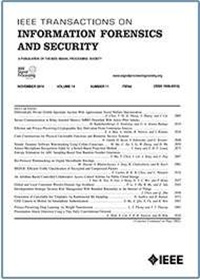利用归一化Logit校准和截断特征混合改进可转移目标对抗攻击
IF 8
1区 计算机科学
Q1 COMPUTER SCIENCE, THEORY & METHODS
IEEE Transactions on Information Forensics and Security
Pub Date : 2025-04-23
DOI:10.1109/TIFS.2025.3563820
引用次数: 0
摘要
本文旨在提高攻击成功率相对较低的针对性攻击中对抗性样本的可转移性。为了实现这一目标,我们从损失和特征两个方面提出了两种不同的技术来提高目标可转移性。首先,在以前的方法中,目标攻击中使用的logit校准主要关注样本中目标类与非目标类之间的logit裕度,而忽略了logit的标准差。在此基础上,提出了一种同时考虑对数边际和对数标准差的归一化对数标定方法。这种方法有效地校准了逻辑,增强了目标的可转移性。其次,以往的研究表明,在优化过程中混合干净样品的特征可以显著提高可转移性。在此基础上,我们进一步研究了截断特征混合方法,以减少源训练模型的影响,从而获得额外的改进。截断的特征是通过去除与从干净样本的高级卷积层分解的最大奇异值相关的Rank-1特征来确定的。在ImageNet-Compatible, CIFAR-10和ImageNet-1k数据集上进行的大量实验证明了我们提出的两个组件的单独和相互好处,它们在黑盒目标攻击中表现优于最先进的方法。本文章由计算机程序翻译,如有差异,请以英文原文为准。
Improving Transferable Targeted Adversarial Attack via Normalized Logit Calibration and Truncated Feature Mixing
This paper aims to enhance the transferability of adversarial samples in targeted attacks, where attack success rates remain comparatively low. To achieve this objective, we propose two distinct techniques for improving the targeted transferability from the loss and feature aspects. First, in previous approaches, logit calibrations used in targeted attacks primarily focus on the logit margin between the targeted class and the untargeted classes among samples, neglecting the standard deviation of the logit. In contrast, we introduce a new normalized logit calibration method that jointly considers the logit margin and the standard deviation of logits. This approach effectively calibrates the logits, enhancing the targeted transferability. Second, previous studies have demonstrated that mixing the features of clean samples during optimization can significantly increase transferability. Building upon this, we further investigate a truncated feature mixing method to reduce the impact of the source training model, resulting in additional improvements. The truncated feature is determined by removing the Rank-1 feature associated with the largest singular value decomposed from the high-level convolutional layers of the clean sample. Extensive experiments conducted on the ImageNet-Compatible, CIFAR-10 and ImageNet-1k datasets demonstrate the individual and mutual benefits of our proposed two components, which outperform the state-of-the-art methods by a large margin in black-box targeted attacks.
求助全文
通过发布文献求助,成功后即可免费获取论文全文。
去求助
来源期刊

IEEE Transactions on Information Forensics and Security
工程技术-工程:电子与电气
CiteScore
14.40
自引率
7.40%
发文量
234
审稿时长
6.5 months
期刊介绍:
The IEEE Transactions on Information Forensics and Security covers the sciences, technologies, and applications relating to information forensics, information security, biometrics, surveillance and systems applications that incorporate these features
 求助内容:
求助内容: 应助结果提醒方式:
应助结果提醒方式:


